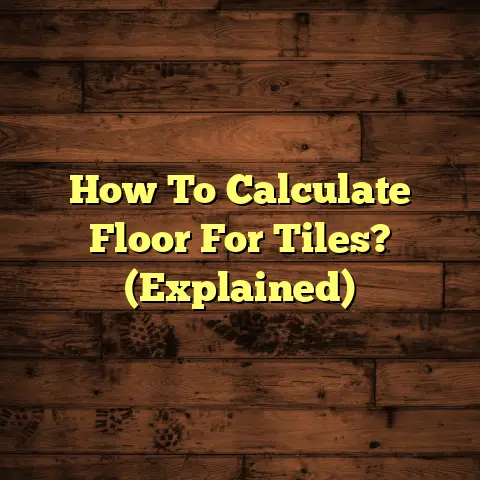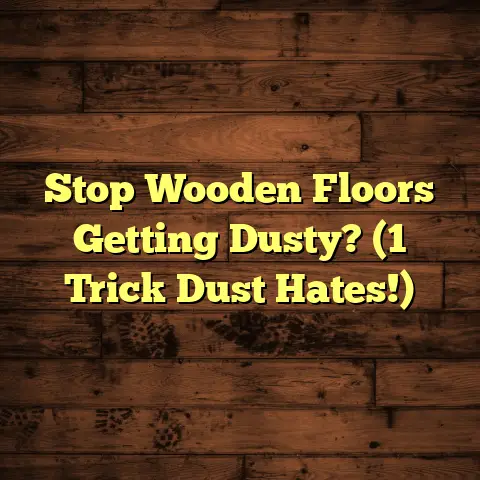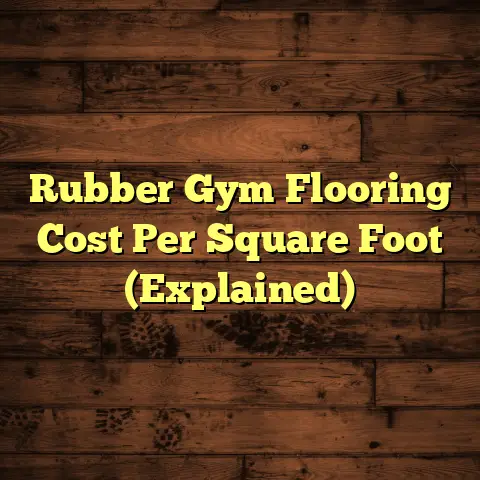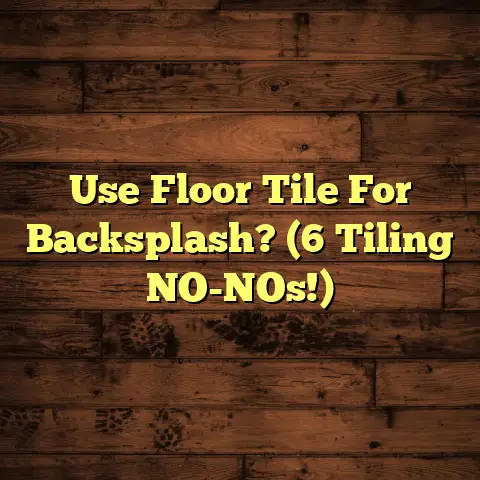Hardwood Refinishing: Cost Estimate? (6 Factors Here!)
Did you know that refinishing hardwood floors
can dramatically increase the value of your
home, sometimes by thousands of dollars, yet
many homeowners overlook this cost-effective
upgrade?
I’ve seen it happen time and again.
A fresh coat of finish can breathe new life
into tired floors, making your whole house
feel brighter and more modern.
But how much
does it really cost?
Let’s dive in!
Understanding Hardwood Refinishing
So, what exactly is hardwood refinishing?
Simply put, it’s the process of sanding down
the existing finish on your hardwood floors
and applying a new protective coating.
This
removes scratches, dents, and other blemishes,
restoring the wood to its original beauty.
Think of it like this: your floors are like
a well-loved car.
Over time, the paint gets
scratched and faded.
Refinishing is like
getting a new paint job – it makes everything
look shiny and new again!
Why is refinishing so important?
Well,
besides the obvious aesthetic benefits, it
also protects the wood from moisture and
wear.
A good finish acts as a barrier,
preventing water damage and extending the
life of your floors.
How does refinishing differ from replacement?
That’s a great question!
Replacement means
tearing out the old floors and installing
new ones.
Refinishing, on the other hand,
works with the existing wood.
As long as
your floors are structurally sound and have
enough thickness left, refinishing is a much
more cost-effective option.
I often tell
people, “Don’t replace if you can refinish!”
The Average Cost of Hardwood Refinishing
Alright, let’s get down to brass tacks.
What’s the average cost?
Generally, you
can expect to pay anywhere from $3 to $8
per square foot to refinish hardwood floors.
I know, that’s a pretty wide range!
Why the big difference?
Well, several
factors can influence the overall cost,
including the type of wood, the condition
of the floors, the size of the area, the
refinishing method, labor costs, and any
additional services you might need.
We’ll
break down each of these in detail.
Keep in mind that geographical location and
market demand also play a role.
Prices can
vary significantly from one city to another.
For example, refinishing in a major
metropolitan area like New York City or San
Francisco will likely cost more than in a
smaller town.
In my experience, checking
with several local contractors for quotes
is always the best way to get an accurate
estimate for your specific project.
Factor 1: Type of Wood
Believe it or not, the type of wood your
floors are made of can significantly impact
the cost of refinishing.
Different woods have
different properties that affect how easily
they can be sanded and finished.
Oak is one of the most common types of
hardwood flooring, and it’s generally
relatively easy to refinish.
This makes it
a more affordable option.
Maple, on the other
hand, is a harder wood with a tighter grain.
This can make it more challenging to sand
and stain, potentially increasing the cost.
Walnut is another beautiful hardwood that’s
often used for flooring.
It’s a softer wood
than oak or maple, which means it can be
more prone to scratches and dents.
Refinishing
walnut floors may require extra care and
attention, adding to the overall expense.
Here’s a quick rundown:
- Oak: Typically the most affordable to refinish.
- Maple: Can be more expensive due to its hardness.
- Walnut: Requires careful handling and may incur higher costs.
The characteristics of each wood type affect
the refinishing process in several ways.
For example, oak is very porous, which means
it absorbs stain easily.
Maple, on the other
hand, is less porous and can be more difficult
to stain evenly.
Walnut has a rich, natural
color that many homeowners choose to preserve,
which may require a different approach to
refinishing.
Factor 2: Condition of the Floors
The current state of your hardwood floors
is another major factor that influences
the cost of refinishing.
Floors with minor
scratches and dents will be much easier
and less expensive to refinish than floors
with extensive damage.
If your floors have deep scratches, gouges,
or water damage, they may require extensive
repairs before refinishing can even begin.
This could involve replacing damaged boards,
filling in cracks, or leveling uneven surfaces.
These repairs can significantly drive up
the overall cost.
I’ve seen floors that were so badly damaged
that they required almost as much work as
installing new floors!
In those cases, it’s
important to weigh the cost of repairs
against the cost of replacement.
Sometimes,
it’s simply more economical to start fresh.
Here’s what to consider:
- Minor scratches and dents: Relatively inexpensive to fix.
- Deep scratches and gouges: Require more extensive sanding and filling.
- Water damage: May necessitate board replacement.
The more work that’s needed to prepare the
floors for refinishing, the higher the cost
will be.
It’s always a good idea to have
a professional assess the condition of your
floors and provide a detailed estimate before
you commit to any work.
Factor 3: Area to be Refinished
This one seems obvious, but it’s worth
emphasizing: the size of the area you’re
refinishing directly affects the cost.
The
larger the area, the more labor and materials
will be required.
However, there’s a bit of a twist.
Larger
areas often come with a lower cost per square
foot due to economies of scale.
Contractors
can often offer a discount for larger jobs
because they can spread out their setup and
cleanup costs over a larger area.
For example, refinishing a small hallway
might cost $8 per square foot, while refinishing
an entire living room might cost $6 per
square foot.
It’s all about efficiency!
Here’s a simple illustration:
These are just ballpark figures, of course,
but they illustrate the general principle.
It’s always a good idea to get quotes from
multiple contractors to see how they price
different sized jobs.
Factor 4: Refinishing Method
There are several different methods for
refinishing hardwood floors, and the method
you choose will affect both the cost and
the final appearance of your floors.
The
two most common methods are screen and recoat
and sand and finish.
Screen and Recoat: This is a less
intensive method that involves lightly
abrading the existing finish and applying
a new coat of finish.
It’s a good option
for floors that are in relatively good
condition and only have minor scratches or
wear.
It’s also a more affordable option
than sand and finish.
Sand and Finish: This is a more
thorough method that involves sanding down
the existing finish completely, removing
any scratches, dents, or imperfections.
Once the floor is sanded smooth, a new
stain and finish are applied.
This method
is ideal for floors that are heavily damaged
or that you want to stain a different color.
Here’s a quick comparison:
The chosen method affects both the cost and
the final appearance of the floor.
Screen
and recoat is a quick and easy way to freshen
up your floors, but it won’t remove deep
scratches or imperfections.
Sand and finish
is a more labor-intensive process, but it
can completely transform your floors and
give them a brand-new look.
Factor 5: Labor Costs
Labor costs are a significant component
of the overall refinishing budget.
The
amount you’ll pay for labor will depend
on the complexity of the job, the experience
of the contractor, and the prevailing wage
rates in your area.
Hiring professional services versus DIY can
lead to significant cost differences.
While
DIY refinishing might seem like a way to
save money, it can actually end up costing
you more in the long run if you make mistakes.
Refinishing hardwood floors requires specialized
equipment and skills, and it’s easy to damage
the floors if you don’t know what you’re doing.
I’ve seen homeowners who tried to refinish
their own floors and ended up with uneven
sanding, swirl marks, and blotchy stain.
In those cases, they had to hire a professional
to fix their mistakes, which ended up costing
them even more than if they had hired a pro
in the first place!
Here’s the bottom line:
- Professional labor: Higher upfront cost, but ensures quality workmanship.
- DIY: Lower upfront cost, but carries a higher risk of mistakes and additional expenses.
In my opinion, hiring a professional is
almost always worth the investment.
A good
contractor will have the experience, equipment,
and skills to do the job right, and they’ll
stand behind their work.
Factor 6: Additional Services
Finally, let’s talk about additional services
that may be bundled with refinishing.
These
can include repairs, staining, and sealing.
These add-ons can affect the final cost
estimate, so it’s important to understand
what’s included in your quote.
Repairs: As we discussed earlier,
extensive repairs can significantly increase
the cost of refinishing.
This might involve
replacing damaged boards, filling in cracks,
or leveling uneven surfaces.
Staining: If you want to change the
color of your floors, you’ll need to have
them stained.
Staining can add to the cost
of refinishing, but it can also dramatically
transform the look of your floors.
Sealing: Sealing is an essential step
in the refinishing process.
It protects
the wood from moisture and wear and helps
to ensure that your floors look beautiful
for years to come.
Here’s a summary of common add-on services:
- Repairs: Fixing damaged boards or uneven surfaces.
- Staining: Changing the color of the floors.
- Sealing: Protecting the wood from moisture and wear.
Be sure to ask your contractor for a detailed
breakdown of all the services included in
the quote.
This will help you understand
exactly what you’re paying for and avoid
any surprises down the road.
Conclusion
So, there you have it!
The six key factors
that influence the cost of hardwood refinishing:
type of wood, condition of the floors, area
to be refinished, refinishing method, labor
costs, and additional services.
While the initial investment may seem daunting,
the long-term benefits and aesthetic appeal
of refinished hardwood can be well worth
the expense.
Refinishing can breathe new
life into your home, increase its value,
and provide you with beautiful floors that
you’ll enjoy for years to come.
Remember to get quotes from multiple
contractors, ask lots of questions, and
choose a contractor who you trust and who
has a proven track record of quality
workmanship.
With a little bit of planning
and research, you can transform your hardwood
floors and create a home that you’ll love
for years to come!





